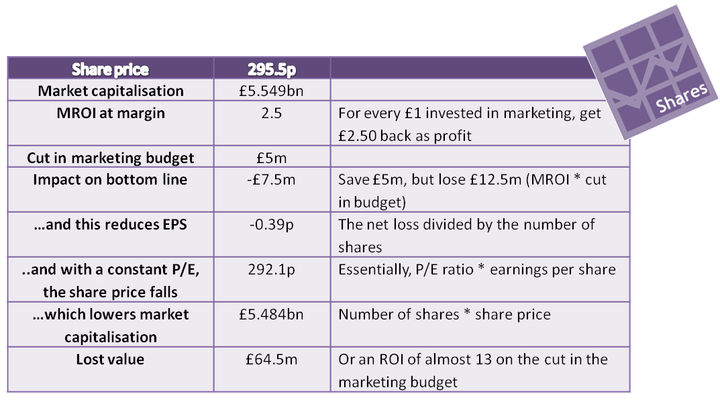The concept of 'Marketing Return on Investment' (MROI) is in need of a dramatic overhaul. Marketing departments are facing new challenges. Simply improving sales and showing you've done so is no longer enough, Marketing Managers must also be able to demonstrate greater value and prove the true impact of every element of their activity - from email campaigns and online banner ads, through to direct mail and TV advertising.
With marketing departments facing increasing internal pressure from their finance and sales teams to cut costs, it's become vitally important to identify new mechanics that can meaningfully justify their spend to the Board, particularly as marketing is now being seen more as a cost that can be cut than an on-going investment.
So why not treat this spend as you would any other cost to the business, by relating it back to your bottom line and, more importantly, the share price? We all think about the bottom line, but share price isn't normally factored in directly. Lately I've started thinking that it should (and could) be.
Measuring the short term effect of (for example) an advertising campaign is of course important. Amongst other things it allows marketers to evaluate and amend what they are doing as the campaign progresses, but short term measurement doesn't help when it comes to understanding the bigger picture. Even when long-term effects are measured under-reporting of the true financial impact is likely. Why? Because standard approaches fail to take into account the potential impact on a company's share price. This isn't because it's not viewed as being important, more that no one has put forward a way to measure it accurately.
Imagine the scenario. Your Finance Director needs to cut back on spending. They identify the areas where they might be able to reduce costs and then stop and ask themselves- should I get the Marketing Manager to cut their budget? Now, on first reflection, it might appear to them that the risk of cutting this type of spend is comparatively low. Do it and your bottom line will instantly look a lot healthier. But this got me thinking, is that really giving an accurate picture? Can this be properly evaluated? A simple mathematical approach reveals such measures to be a false economy.

We can add in additional detail like deleveraging and interest payments as well as the impact on investor sentiment, but these are details and don't affect the thrust of the argument.
I think this method makes it possible to track marketing effectiveness back to the share price. If you consider that your marketing activity usually creates (for example) a 2.5 return in terms of margin, cost cutting of this type starts to look less appealing. If your annual marketing budget is £10m and you decide to halve it, that £5m cut may increase your cash flow in the short-term and win you favour with the Board. But the long-term impact is a £12.5m drop in profit and a net loss of £7.5m.
So what seemed like a clever cost cutting mission to begin with actually costs the business money. You might end up losing more money than you save. Of-course, your FD might question the ROI calculation and on balance of risk, cut the budget anyway. But the actual loss could turn into a much more serious mistake in the long run, having a huge impact on the profitability of the company and ultimately the share price. For this reason alone it will always be worth making the case against such measures being taken. The figures break down link this...

As the table shows, the potential loss working through a lower share price and market capitalisation is actually closer to £60m than £7.5m. And while the FD might still question the ROI calculation, the balance of risk begins to shift when you look at the numbers in this way.
All other significant investments are evaluated in terms of their impact on profit, with calculated internal rates of return and the opportunity cost of the capital invested. Why don't we look at marketing in the same way? Or is this too much of a simplification? Are there other variables to be looked at that I've failed to mention? I'd welcome your thoughts...
